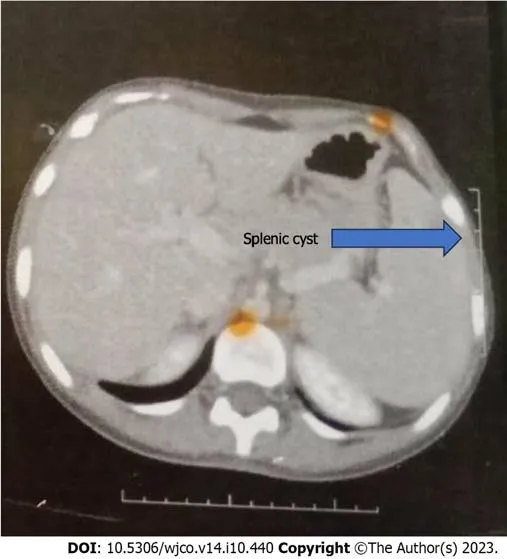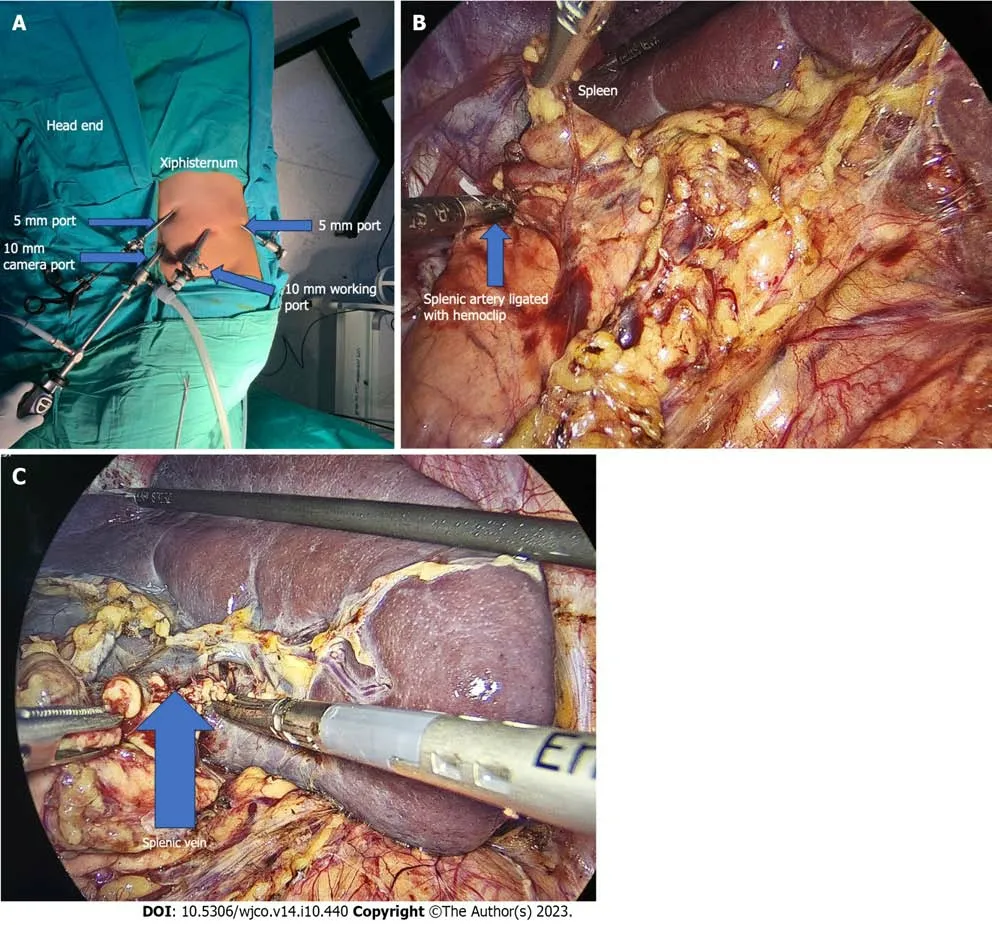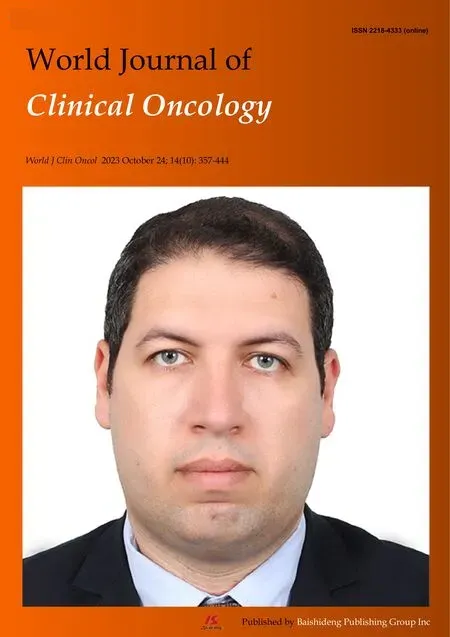Splenic lymphangioma masquerading as splenic abscess managed by laparoscopic splenectomy: A case report
Santosh Thorat,Febin Mohammed Shaji
Abstract BACKGROUND Primary benign splenic tumours are unique and account for <0.007% of all tumours identified during surgery and autopsy.Splenic lymphangiomas are rarely seen in adults.Splenic lymphangiomas may be asymptomatic,or may present with upper left abdominal pain,splenomegaly,hypersplenism,or splenic rupture with haemorrhagic shock.The clinical and radiological features of these lesions are not specific.This case report serves to remind the clinician to consider the rare but important differential diagnosis of splenic lymphangioma while treating splenic lesions.CASE SUMMARY We report a case of splenic lymphangioma in a 22-year-old woman who presented with left upper quadrant abdominal pain for three months.Initial investigations were unremarkable;however,computed tomography later revealed multiple splenic micro-abscesses.The patient underwent laparoscopic splenectomy,and histopathological examination revealed splenic lymphangioma.The patient was discharged on postoperative day three.One month after surgery,the abdominal pain resolved completely,with no new complaints.Splenic lymphangiomas present clinically as splenomegaly or left upper quadrant abdominal pain;prompt intervention is necessary for avoiding complications.CONCLUSION This case report concludes that splenic lymphangiomas should be considered in the differential diagnosis of splenomegaly or left upper quadrant pain,even in adults,because they are amenable to curative treatment.Delays in surgical intervention may lead to severe complications,such as infection,rupture,and hemorrhage.Such lesions can be safely managed with laparoscopy,involving less postoperative pain and early patient discharge with excellent cosmetic outcomes.
Key Words: Spleen;Lymphangioma;Oncology;Rare;Laparoscopic splenectomy;Hamartomatous process;Case report
INTRODUCTION
Lymphangiomas are benign congenital malformations of the lymphatic vessels,commonly localised to the head,neck,and axillary regions.Intra-abdominal localisation is rare and occurs preferentially in the mesentery.Splenic lymphangiomas occur mainly in children and rarely in adults.Between 1939 and 2017,only 209 cases of splenic lymphangiomas in adults have been reported in the literature[1].The rarity of lymphangiomas and their uncommon localisation pose a challenge for clinicians in making accurate preoperative diagnosis.
CASE PRESENTATION
Chief complaints
Complaints of intermittent left upper quadrant abdominal pain and fever for the three months.
History of present illness
Complaints of intermittent left upper quadrant abdominal pain and fever for the past three months,for which she had consulted multiple medical practitioners with no relief from her agony.
History of past illness
No history of any significant illness in the past.
Personal and family history
No significant personal or family history.
Physical examination
Physical examination results were unremarkable,except for mild tenderness on deep palpation in the left upper abdomen.
Laboratory examinations
Initial investigations,including blood tests,were unremarkable,except for a slight elevated white blood cell count.
The patient was investigated for possible sources of infection;blood cultures,urine cultures,sputum cultures were performed.Additionally,an infection panel screening was performed,and the result was negative.Cultures were also negative for the presence of any infection.
Imaging examinations
Abdominal ultrasonography revealed multiple splenic micro-abscesses.Further workup with contrast-enhanced computed tomography of the abdomen revealed splenomegaly and multiple hypodense lesions in the splenic parenchyma (the largest measuring 15 mm × 15 mm),suggestive of multiple splenic abscesses/cysts (Figure 1).The splenic vein and distal Superior Mesenteric Artery were dilated,indicating portal hypertension.Other findings included a right-sided hemorrhagic ovarian cyst.Upper gastrointestinal endoscopy was performed for portal hypertension,which showed mild gastritis and a Hill’s grade 1 hiatal hernia.

Figure 1 Contrast-enhanced computed tomography film showing splenic cyst.
FINAL DIAGNOSIS
Splenic lymphangioma.
TREATMENT
Laparoscopic splenectomy.
OUTCOME AND FOLLOW-UP
The patient was admitted to our hospital and prepared for laparoscopic splenectomy (Figure 2).She was started on intravenous third generation cephalosporins and metronidazole to provide aerobic and anaerobic coverage,respectively,and administered vaccinations (including meningococcal,pneumococcal,andH.Influenzavaccines) 14 d before the surgery.
The patient underwent laparoscopic splenectomy.She was placed in the supine position,and the surgeon was positioned at the right lower side.
The spleen was removed using a Pfannenstiel incision,which was closed cosmetically with subcuticular sutures.
The total operative time was 160 min,with an estimated blood loss of 110 mL.Drains were placed at the postoperative site because the spleen formed adhesions with the pancreas.The drains were kept in place to check for any leakage,and they were removed on postoperative day (POD) two.The postoperative period was uneventful,and the patient was discharged on POD three.
The splenectomy specimen was sent for histopathological examination (Figure 3A).The spleen weighed 247 g.Histological examination findings revealed lymphangioma of the spleen,with areas of congestive splenomegaly (Figure 3B).
Postoperatively,all precautions were taken to prevent hospital acquired infections.The patient was advised to immediately present to the hospital in case fever develops after hospital discharge.One month after surgery,the abdominal pain resolved completely,with no new complaints.
DISCUSSION

Figure 2 Laparoscopic splenectomy.A: Port placement for laparoscopic splenectomy;B: Intraoperative view of the splenic artery ligated with a haemoclip at the upper border of the pancreas;C: Intraoperative view of the spleen.
Splenic lymphangioma is an uncommon malformation of the lymphatics of spleen mainly seen in children and rarely in adults.Although its aetiology is unclear,it is widely regarded as a hamartomatous change rather than a neoplasm[2].Histologically,splenic lymphangiomas are characterised by cystic spaces lined by attenuated endothelial cells[3].This condition may present involving only the spleen.However,in most cases,it is part of a systemic involvement of the lymphatic channels affecting multiple organs (systemic lymphangiomatosis)[4].Most lesions are detected in imaging studies incidentally,whereas larger lesions can cause compression symptoms due to pressure on adjacent organs.
CONCLUSION
This case report concludes that in patients presenting with splenomegaly and left upper abdominal pain,splenic lymphangioma should be considered as an important differential diagnosis.Missed diagnosis and delayed treatment can lead to serious complications such as rupture and hemorrhage[5].Such lesions can be safely managed with laparoscopy,involving less postoperative pain and early patient discharge with excellent cosmetic outcomes.

Figure 3 Splenectomy specimen and histopathological slide.A: Splenectomy specimen;B: Histopathological slide showing multiple cystic spaces filled with eosinophilic proteinaceous material.
FOOTNOTES
Author contributions:Thorat S performed the surgery and was the chief consultant surgeon;Shaji FM assisted the case and compiled the information and created the manuscript.
Informed consent statement:The study participant,provided informed written consent prior to study enrollment.
Conflict-of-interest statement:No conflicts of interest declared.
CARE Checklist (2016) statement:The authors have read the CARE Checklist (2016),and the manuscript was prepared and revised according to the CARE Checklist (2016).
Open-Access:This article is an open-access article that was selected by an in-house editor and fully peer-reviewed by external reviewers.It is distributed in accordance with the Creative Commons Attribution NonCommercial (CC BY-NC 4.0) license,which permits others to distribute,remix,adapt,build upon this work non-commercially,and license their derivative works on different terms,provided the original work is properly cited and the use is non-commercial.See: https://creativecommons.org/Licenses/by-nc/4.0/
Country/Territory of origin:India
ORCID number:Santosh Thorat 0009-0004-4801-4847;Febin Mohammed Shaji 0009-0008-2802-0384.
S-Editor:Fan JR
L-Editor:A
P-Editor:Zhang XD
 World Journal of Clinical Oncology2023年10期
World Journal of Clinical Oncology2023年10期
- World Journal of Clinical Oncology的其它文章
- Classification of patients with metastatic colorectal cancer into consensus molecular subtypes into real-world: A pilot study
- Treatment of patients with multiple brain metastases by isolated radiosurgery: Toxicity and survival
- Hub genes and their key effects on prognosis of Burkitt lymphoma
- What should be the future direction of development in the field of prostate cancer with lung metastasis?
- Comprehensive analysis of disulfidptosis related genes and prognosis of gastric cancer
